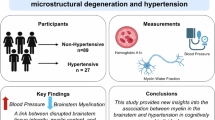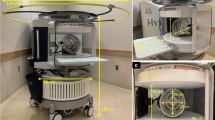Abstract
Malignant hypertension (MHT) crisis triggers widespread microvascular damage, particularly in the brain. Despite recent MRI evidence highlighting acute cerebral injuries during MHT crises, follow-up data remain scarce. This study seeks to fill this gap by exploring how brain MRI markers evolve following acute MHT crisis management. We conducted a retrospective analysis of brain MRI data from MHT patients admitted to Bordeaux University Hospital between 2008 and 2022. Eligible patients had at least one follow-up MRI. Analysis blinded to clinical data was performed to identify markers of posterior reversible encephalopathy syndrome (PRES), acute stroke, cerebral hemorrhage, and microangiopathy. Out of 149 patients, 47 had follow-up MRIs. Most were male (72.3%) with a mean age of 48.2 ± 10.8 years. The median interval between initial and follow-up MRI was 228 days. Follow-up MRIs revealed new strokes in 10.6% of patients, cerebral hemorrhages in 4.3%, and no cases of PRES. Additionally, more patients exhibited chronic lacunar infarcts and/or microbleeds, with overall Fazekas scores remaining stable in 66.0%, improving in 31.9%, and worsening in 2.1%. Subgroup analyses based on blood pressure control or follow-up duration showed no significant differences in MRI markers. This study sheds light on the risk of new cerebrovascular events and the dynamic changes in brain MRI markers following acute MHT crisis management. Understanding these changes could lead to improved diagnosis, personalized treatment strategies, and proactive patient care for individuals with MHT.
This is a preview of subscription content, access via your institution
Access options
Subscribe to this journal
Receive 12 digital issues and online access to articles
$119.00 per year
only $9.92 per issue
Buy this article
- Purchase on SpringerLink
- Instant access to full article PDF
Prices may be subject to local taxes which are calculated during checkout



Similar content being viewed by others
Data availability
The datasets generated and analyzed during the current study are available from the corresponding author on reasonable request.
References
Shantsila A, Lip GYH. Malignant Hypertension Revisited-Does This Still Exist? Am J Hypertens. 2017;30:543–9.
Cremer A, Amraoui F, Lip GYH, Morales E, Rubin S, Segura J, et al. From malignant hypertension to hypertension-MOD: a modern definition for an old but still dangerous emergency. J Human Hypertens. 2016;30:463–6.
van den Born BJH, Koopmans RP, van Montfrans GA. The renin-angiotensin system in malignant hypertension revisited: plasma renin activity, microangiopathic hemolysis, and renal failure in malignant hypertension. Am J Hypertens. 2007;20:900–6.
Shantsila A, Shantsila E, Beevers DG, Lip GYH. Predictors of 5-year outcomes in malignant phase hypertension: the West Birmingham Malignant Hypertension Registry. J Hypertens. 2017;35:2310–4.
Keith NM, Wagener HP. Kernohan JW. The syndrome of malignant hypertension. Arch Internal Med. 1928;41:141–88.
Lip GY, Beevers M, Beevers G. The failure of malignant hypertension to decline: a survey of 24 years’ experience in a multiracial population in England. J Hypertens. 1994;12:1297–305.
van den Born BJH, Lip GYH, Brguljan-Hitij J, Cremer A, Segura J, Morales E, et al. ESC Council on hypertension position document on the management of hypertensive emergencies. Eur Heart J Cardiovasc Pharmacother. 2019;5:37–46.
Rubin S, Cremer A, Boulestreau R, Rigothier C, Kuntz S, Gosse P. Malignant hypertension: diagnosis, treatment and prognosis with experience from the Bordeaux cohort. J Hypertens. 2018;36:1–9.
Boulestreau R, Lucas L, Cremer A, Debeugny S, Rubin S, Gaudissard J, et al. Neurologically asymptomatic patients frequently present cerebral injuries during malignant hypertension: a MRI study. J Hypertens. 2021;39:2463–9.
Williams B, Mancia G, Spiering W, Agabiti Rosei E, Azizi M, Burnier M, et al. 2018 ESC/ESH Guidelines for the management of arterial hypertension: The Task Force for the management of arterial hypertension of the European Society of Cardiology and the European Society of Hypertension: The Task Force for the management of arterial hypertension of the European Society of Cardiology and the European Society of Hypertension. J Hypertens. 2018;36:1953–2041.
Vaughan CJ, Delanty N. Hypertensive emergencies. Lancet. 2000;356:411–7.
Fazekas F, Chawluk JBAA. MR signal abnormalities at 1.5 T in Alzheimer’s dementia and normal aging. AJR. Am J Roentgenol. 1987;149:351–6.
Zhu YC, Dufouil C, Mazoyer B, Soumaré A, Ricolfi F, Tzourio C, et al. Frequency and location of dilated Virchow-Robin spaces in elderly people: A population-based 3D MR imaging study. Am J Neuroradiol. 2011;32:709–13.
Wardlaw JM, Smith EE, Biessels GJ, Cordonnier C, Fazekas F, Frayne R, et al. Neuroimaging standards for research into small vessel disease and its contribution to ageing and neurodegeneration. Lancet Neurol. 2013;12:822–38.
Staals J, Makin SDJ, Doubal FN, Dennis MS, Wardlaw JM. Stroke subtype, vascular risk factors, and total MRI brain small-vessel disease burden. Neurology. 2014;83:1228–34.
Denolle T, Asmar R, Boivin JM, Girerd X, Le Jeune S, Vaisse B, et al. Recommandations sur la mesure de la pression artérielle. Consensus d’experts de la Société française d’hypertension artérielle, filiale de la Société française de cardiologie. La Presse Médicale. 2019;48:1319–28.
Jochems ACC, Arteaga C, Chappell F, Ritakari T, Hooley M, Doubal F, et al. Longitudinal Changes of White Matter Hyperintensities in Sporadic Small Vessel Disease: A Systematic Review and Meta-analysis. Neurology. 2022;99:e2454–63.
Debette S, Markus HS. The clinical importance of white matter hyperintensities on brain magnetic resonance imaging: systematic review and meta-analysis. BMJ. 2010;341:c3666.
Amraoui F, Bos S, Vogt L, van den Born BJ. Long-term renal outcome in patients with malignant hypertension: a retrospective cohort study. BMC Nephrol. 2012;13:71.
Bretzner M, Bonkhoff AK, Schirmer MD, Hong S, Dalca AV, Donahue KL, et al. MRI Radiomic Signature of White Matter Hyperintensities Is Associated With Clinical Phenotypes. Front Neurosci. 2021;15:691244.
Min ZG, Shan HR, Xu L, Yuan DH, Sheng XX, Xie WC, et al. Diffusion tensor imaging revealed different pathological processes of white matter hyperintensities. BMC Neurol. 2021;21:128.
Armstrong NJ, Mather KA, Sargurupremraj M, Knol MJ, Malik R, Satizabal CL, et al. Common Genetic Variation Indicates Separate Causes for Periventricular and Deep White Matter Hyperintensities. Stroke. 2020;51:2111–21.
Iadecola C, Yaffe K, Biller J, Bratzke LC, Faraci FM, Gorelick PB, et al. Impact of Hypertension on Cognitive Function: A Scientific Statement From the American Heart Association. Hypertension. 2016;68:e67–94.
Acknowledgements
We thank Ray Cooke for reviewing the English in the manuscript, and Christel Baigts for editing.
Author information
Authors and Affiliations
Contributions
RB was responsible for study design and conception, patient follow-up, data collection, data analysis and manuscript redaction and review. JSL was responsible for critical analysis of final data and manuscript redaction. AC, PG, JD were responsible for patient follow-up, data collection, critical input and manuscript review. LL was responsible for radiological analysis and manuscript review. SD, SR and IS were responsible for critical input and manuscript review. All authors provided critical feedback and helped shape the research, analysis and manuscript.
Corresponding author
Ethics declarations
Competing interests
The authors declare no competing interests.
Additional information
Publisher’s note Springer Nature remains neutral with regard to jurisdictional claims in published maps and institutional affiliations.
Rights and permissions
Springer Nature or its licensor (e.g. a society or other partner) holds exclusive rights to this article under a publishing agreement with the author(s) or other rightsholder(s); author self-archiving of the accepted manuscript version of this article is solely governed by the terms of such publishing agreement and applicable law.
About this article
Cite this article
Liegey, J.S., Cremer, A., Lucas, L. et al. Course of brain damage following malignant hypertension. J Hum Hypertens 39, 38–45 (2025). https://doi.org/10.1038/s41371-024-00968-5
Received:
Revised:
Accepted:
Published:
Issue date:
DOI: https://doi.org/10.1038/s41371-024-00968-5



